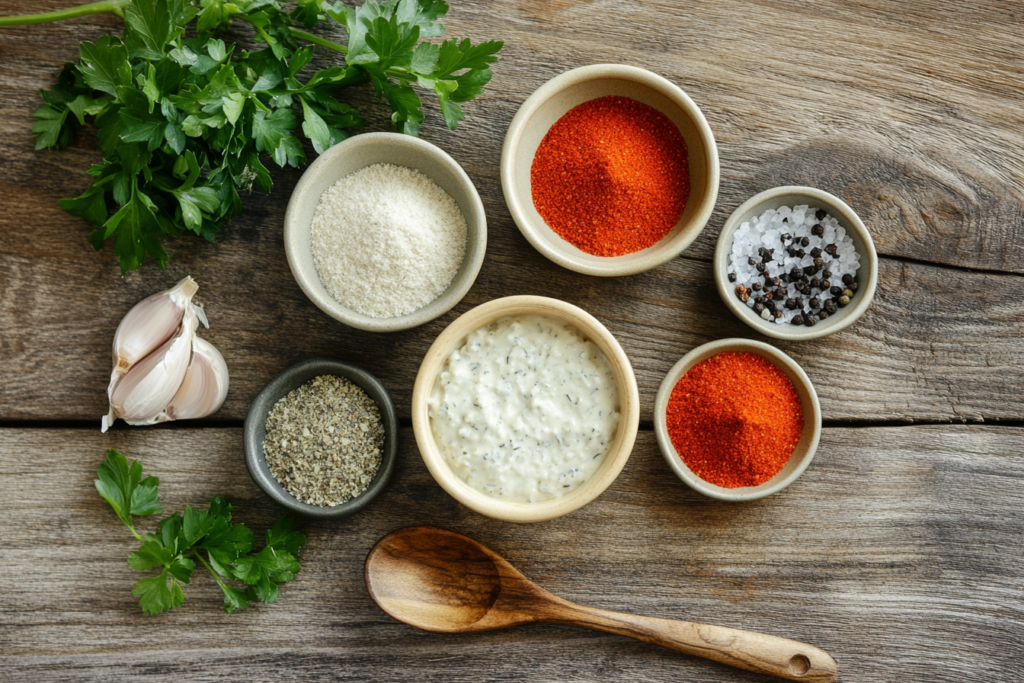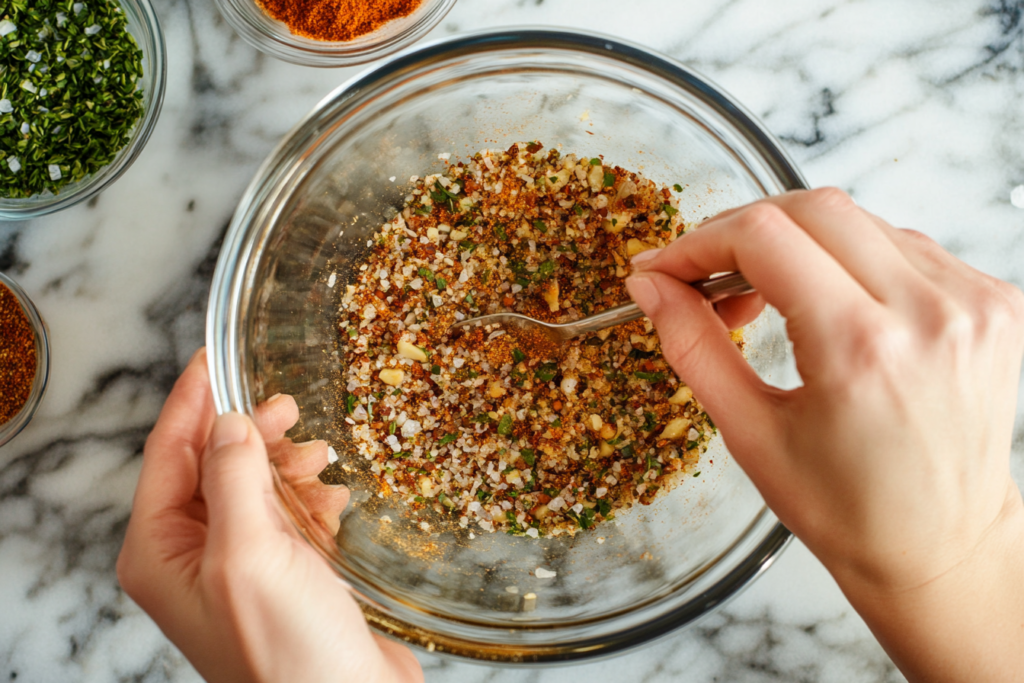Table of contents
What is Philly Cheesesteak Seasoning?
Philly Cheesesteak seasoning is a blend of spices and herbs that encapsulates the rich, savory flavor profile of the iconic Philly cheesesteak sandwich. Moreover, this seasoning is designed to complement the dish’s core ingredients—thinly sliced beef, sautéed onions, and melted cheese—while also offering a balance of flavor that enhances the overall taste experience. In addition, its versatility makes it a key component for recreating authentic Philly cheesesteak dishes at home.
Origins and History of Philly Cheesesteak Seasoning
The Philly cheesesteak sandwich originated in Philadelphia, Pennsylvania, in the early 20th century. Specifically, Pat Olivieri, a hot dog vendor, is credited with creating the first cheesesteak in the 1930s when he decided to grill beef on his hot dog stand. As the story goes, a cab driver passing by caught the aroma, requested a steak sandwich, and the rest is history. Eventually, the addition of cheese came later, solidifying the cheesesteak as a local and national favorite.
Philly cheesesteak seasoning has its roots in this tradition, evolving to capture the essence of the dish in a convenient, versatile blend. While it may not have been part of the original recipe, the seasoning is a modern development that allows cooks to recreate the authentic taste with ease. Therefore, it has become an essential element for anyone looking to replicate this iconic sandwich.
Defining Key Ingredients in Cheesesteak Seasoning
The ingredients in Philly cheesesteak seasoning vary but typically include a mix of savory, aromatic, and slightly spicy components. Here are the common elements:
- Garlic Powder – Adds a robust, savory undertone.
- Onion Powder – Enhances the flavor of sautéed onions commonly used in the dish.
- Salt and Black Pepper – Basic seasonings to highlight the beef’s natural flavor.
- Paprika – Provides a subtle smoky note and color.
- Cayenne Pepper or Red Pepper Flakes – Adds a hint of heat for depth.
- Dried Oregano or Thyme – Brings an earthy, aromatic quality.
- Ground Mustard – Offers a slight tang to complement the cheese.
- Worcestershire Powder or Soy Powder – Replicates the umami richness of the sauce often paired with cheesesteak.
These ingredients work together to mimic the flavors of a traditional Philly cheesesteak and can be adjusted to personal taste preferences. This seasoning is not only used for cheesesteaks but also finds its way into other dishes, such as fries, burgers, or roasted vegetables, offering a Philly-inspired twist.
The Essential Ingredients for Philly Cheesesteak Seasoning
When crafting the perfect Philly cheesesteak or infusing its flavors into other dishes, first and foremost, understanding the essential ingredients is key. Not only that, from the seasonings and spices to the balance of salt and optional herbs, these components define the classic taste while also allowing room for creative variation. Furthermore, by carefully combining these elements, you can ensure that each dish reflects the authentic flavor profile of a Philly cheesesteak.

Seasonings and Spices in Cheesesteak Flavoring
The heart of any Philly cheesesteak seasoning lies in its flavorful blend of spices. These spices work in harmony to elevate the natural taste of the beef and cheese. Common seasonings include:
- Garlic Powder: A savory staple that adds depth and warmth.
- Onion Powder: Enhances the sweetness of caramelized onions often used in the dish.
- Paprika: Introduces a smoky flavor and vibrant color.
- Cayenne Pepper or Chili Flakes: Provides a subtle kick of heat for those who enjoy a spicy edge.
- Ground Mustard: Adds a tangy brightness that complements the richness of the cheese.
The Role of Salt and Pepper in Philly Cheesesteak Seasoning
No seasoning mix is complete without salt and pepper. These foundational ingredients serve to:
- Salt: Bring out the natural flavors of the beef and other ingredients, enhancing their taste without overpowering them.
- Black Pepper: Adds a mild spiciness and aromatic quality that underscores the seasoning’s savory profile.
The careful balance of salt and pepper ensures that the cheesesteak remains flavorful without being overly salty or bland.
Optional Herbs for Cheesesteak Seasoning Variations
While traditional Philly cheesesteak seasoning sticks to the basics, adding herbs can create delightful variations and personal touches. Some popular options include:
- Oregano: Introduces a Mediterranean flair with its earthy and slightly minty aroma.
- Thyme: Adds a subtle woody and floral note for complexity.
- Parsley: A fresh, grassy herb that lightens the overall flavor profile.
These herbs can be incorporated sparingly for subtle changes or more generously for a distinct twist on the classic seasoning. They’re especially effective when tailoring the seasoning for dishes beyond the cheesesteak, such as pasta, roasted vegetables, or soups.
By mastering these essential ingredients, you can recreate the authentic flavors of Philly cheesesteak while making it uniquely your own.
How to Make Philly Cheesesteak Seasoning at Home
Creating your own Philly cheesesteak seasoning at home is simple and allows you to customize the blend to suit your taste. By following a step-by-step approach and using a few expert tips, you can ensure a perfectly balanced seasoning mix.

Step-by-Step Preparation
- Gather the Ingredients:
- 1 tablespoon garlic powder
- 1 tablespoon onion powder
- 1 teaspoon paprika
- 1 teaspoon ground black pepper
- 1 teaspoon salt
- ½ teaspoon cayenne pepper (optional for heat)
- ½ teaspoon ground mustard
- ½ teaspoon dried oregano or thyme (optional for added depth)
- Measure and Combine:
- Use a clean, dry mixing bowl.
- Measure each ingredient carefully for consistency.
- Combine the spices and herbs in the bowl, ensuring they are evenly distributed.
- Blend Thoroughly:
- Use a whisk or spoon to mix the ingredients until fully integrated.
- If available, transfer the mixture to a spice grinder or food processor for a finer texture.
- Store Properly:
- Transfer the seasoning mix into an airtight container or jar.
- Label the container with the date and name of the seasoning.
- Store in a cool, dark place to preserve freshness, ideally for up to six months.
Tips for Perfect Blending
- Use Fresh Ingredients: Opt for fresh, high-quality spices and herbs to ensure maximum flavor and aroma.
- Adjust for Personal Taste: If you prefer a milder mix, reduce the cayenne pepper. For a zestier kick, increase the ground mustard or black pepper.
- Grind for Uniformity: For a smoother texture, especially if using dried herbs, grind the mixture briefly in a spice grinder.
- Small Batches for Freshness: Make small amounts at a time to maintain the potency of the seasoning.
- Test and Taste: Before storing, sprinkle a pinch on a sample of cooked meat or vegetables to test the flavor balance. Adjust as needed.
Making Philly cheesesteak seasoning at home not only ensures authenticity but also provides the flexibility to tailor the mix for various dishes. For instance, whether seasoning beef, enhancing fries, or even sprinkling on roasted vegetables, this homemade blend is versatile and full of flavor. Furthermore, its adaptability makes it a must-have for recreating iconic tastes in countless recipes.
Secret Techniques for Enhancing Flavor
Elevating the flavor of your Philly cheesesteak seasoning involves more than just the right ingredients—it’s also about using the proper techniques to maximize taste. Two key methods are toasting spices and layering flavors during cooking.
Toasting Spices
Toasting spices is a simple yet transformative step that enhances their natural oils and aromas, adding a depth of flavor to your seasoning.
- How to Toast:
- Heat a dry skillet over medium heat.
- Add your spices, such as paprika, black pepper, or mustard powder, to the skillet.
- Stir constantly to prevent burning, allowing the spices to warm evenly.
- Toast for 1–2 minutes or until you notice a richer aroma.
- Benefits of Toasting:
- Amplifies the flavor profile of individual spices.
- Adds a smoky, nutty quality to the seasoning.
- Ensures that the spices integrate better when used in cooking.
- Pro Tip:
- Toast spices separately and mix them into the seasoning blend afterward to avoid uneven cooking.
Layering Flavors While Cooking
Layering flavors is the technique of building complexity in a dish by adding ingredients at different stages of cooking.
- Start with the Basics:
- Begin by seasoning the beef with a portion of your Philly cheesesteak seasoning. Allow the meat to sit for a few minutes to absorb the flavors.
- Enhance During Cooking:
- While sautéing onions and beef, sprinkle more seasoning into the pan. This step ensures the spices meld with the fats and juices, creating a more robust flavor.
- Finish with a Flourish:
- Add a final dash of seasoning just before serving. This preserves the freshness of the spices and enhances the dish’s aroma.
- Why It Works:
- Early seasoning infuses the meat with flavor.
- Mid-cooking additions intensify the spices by incorporating them into the cooking juices.
- A final sprinkle brightens the overall taste, providing a multidimensional flavor experience.
Combining Both Techniques
Toasting your spices before blending the seasoning, followed by layering flavors during cooking, ensures that your Philly cheesesteak or any other dish reaches its full flavor potential. These techniques are versatile and can be applied to a variety of recipes, making your homemade seasoning an indispensable tool in your kitchen.
Vegetarian and Vegan Alternatives
For those who prefer a plant-based diet, Philly cheesesteak seasoning can still deliver the classic flavors of this beloved dish. With the right plant-based proteins and creative recipe ideas, you can enjoy all the savory goodness without the meat.
Using the Seasoning with Plant-Based Proteins
Philly cheesesteak seasoning pairs well with a variety of plant-based proteins, creating flavorful and satisfying alternatives:
- Seitan:
- Seitan, made from wheat gluten, has a chewy texture similar to beef.
- Slice it thinly and sauté with onions and seasoning for a hearty filling.
- Jackfruit:
- Young jackfruit mimics the texture of shredded meat.
- Marinate jackfruit in the seasoning blend, then cook it down until tender.
- Tofu:
- Press and slice firm tofu into thin strips.
- Pan-fry until crispy edges develop, then season generously.
- Mushrooms:
- Portobello or cremini mushrooms offer a meaty texture and umami flavor.
- Slice and sauté with onions and seasoning for a rich, savory base.
- Plant-Based Beef:
- Many brands of plant-based ground or sliced beef alternatives work perfectly.
- Cook them as you would traditional beef, adding the seasoning for authentic flavor.
Recipe Ideas for Non-Meat Philly Cheesesteaks
Plant-based Philly cheesesteaks are versatile and delicious, offering a satisfying meal for vegetarians and vegans alike. Here are some recipe ideas:
- Classic Vegetarian Philly Cheesesteak:
- Use sautéed mushrooms and onions as the main filling.
- Add provolone or a vegetarian cheese alternative.
- Serve in a toasted hoagie roll for a traditional experience.
- Vegan Cheesesteak with Cashew Cheese:
- Combine seasoned jackfruit or seitan with sautéed onions and peppers.
- Top with a creamy vegan cheese sauce made from blended cashews, nutritional yeast, and spices.
- Load into a dairy-free bun or roll.
- Tofu and Veggie Philly Cheesesteak:
- Sauté thin strips of tofu with bell peppers, onions, and the seasoning blend.
- Sprinkle with vegan mozzarella or a store-bought vegan cheese alternative.
- Serve over a bed of greens or in a wrap for a lighter option.
- Gluten-Free Vegan Philly Cheesesteak:
- Use portobello mushrooms and gluten-free buns.
- Top with dairy-free cheese and roasted vegetables for a hearty yet gluten-free version.
- Philly Cheesesteak Bowl:
- Layer sautéed plant-based beef, onions, peppers, and mushrooms over cooked quinoa or rice.
- Drizzle with vegan cheese sauce for a deconstructed, protein-packed meal.
By pairing Philly cheesesteak seasoning with plant-based proteins and exploring creative recipes, vegetarians and vegans can enjoy the rich, satisfying flavors of this classic dish while staying true to their dietary choices.
Common Mistakes to Avoid
When preparing a Philly cheesesteak or using its signature seasoning, small missteps can impact the dish’s flavor and quality. Avoiding these common mistakes ensures a delicious and authentic result.
Over-Seasoning
- Why It Happens:
- Philly cheesesteak seasoning is flavorful, but excessive use can overpower the natural taste of the beef, onions, and cheese.
- Misjudging the balance of salt, pepper, and spices can result in an overly salty or spicy dish.
- How to Avoid It:
- Start Small: Add the seasoning incrementally, tasting as you go.
- Consider Cheese and Other Ingredients: Remember that cheese and sautéed onions contribute additional flavors and saltiness.
- Measure Carefully: Especially when making a seasoning blend, use precise measurements to maintain balance.
- Pro Tip:
- If you accidentally over-season, dilute the flavors by adding more unseasoned beef or plant-based protein to the dish.
Ignoring Ingredient Quality
- Why It Happens:
- Relying on low-quality or stale spices, subpar cheese, or poorly marbled beef can significantly reduce the flavor of the final dish.
- Skipping fresh ingredients, like onions and peppers, detracts from the authenticity and richness of a cheesesteak.
- How to Avoid It:
- Choose Fresh Spices: Ensure your garlic powder, onion powder, and other spices are fresh and aromatic.
- Select High-Quality Proteins: Opt for thinly sliced ribeye or a premium plant-based alternative.
- Prioritize Fresh Produce: Use fresh onions, peppers, and bread for maximum flavor.
- Pro Tip:
- When purchasing spices, look for brands with a reputation for freshness or buy in small quantities to prevent them from going stale.
By avoiding over-seasoning and focusing on high-quality ingredients, you can ensure your Philly cheesesteak or any dish featuring its flavors delivers a perfectly balanced and satisfying experience.
For those looking to explore creative ways to use Philly Cheesesteak Seasoning, consider trying the Philly Cheesesteak Egg Rolls Recipe, which pairs the seasoning with a crispy and flavorful twist. Additionally, the Philly Cheesesteak Pasta Recipe offers a delicious fusion of classic cheesesteak flavors with comforting pasta, showcasing the versatility of this seasoning. If you’re interested in expanding your culinary adventures, check out these recipes to discover exciting new applications for this flavorful blend.
FAQs on Philly Cheesesteak Seasoning
What is Philly steak seasoning made of?
Philly steak seasoning typically includes a blend of savory spices and herbs designed to enhance the flavors of the classic cheesesteak. Common ingredients include garlic powder, onion powder, paprika, black pepper, salt, cayenne pepper (optional for heat), and sometimes dried herbs like oregano or thyme. This combination ensures a balance of smoky, savory, and slightly spicy flavors that complement the beef and cheese.
What is the secret ingredient in Philly cheesesteak?
The “secret ingredient” often lies in the simplicity of the ingredients and their quality. Some say the secret is in the choice of cheese, such as provolone, American cheese, or Cheez Whiz, which melts perfectly into the steak. Others attribute it to the quality of the beef, with thinly sliced ribeye being the gold standard, or the seasoning blend that brings out the rich, savory flavors. A touch of Worcestershire sauce or soy sauce in the seasoning mix can also add an umami kick, making it a well-kept secret in many recipes.
What makes a Philly cheesesteak taste like a Philly cheesesteak?
The distinctive taste of a Philly cheesesteak comes from a combination of high-quality ingredients and their preparation. Thinly sliced ribeye steak, seasoned and cooked to perfection, forms the flavorful base. Caramelized onions add sweetness, while the melted cheese binds the sandwich together with a creamy, rich texture. The hoagie roll, ideally soft yet sturdy, completes the authentic experience. The seasoning blend enhances these core elements, ensuring the dish’s iconic savory and slightly smoky profile.
What does a traditional Philly cheesesteak have on it?
A traditional Philly cheesesteak consists of thinly sliced ribeye steak, sautéed onions, and melted cheese served on a soft hoagie roll. The cheese options are typically provolone, American cheese, or Cheez Whiz, depending on personal preference. While the basic recipe is simple, some variations include green bell peppers, mushrooms, or additional condiments like ketchup or mayo. However, purists argue that the classic Philly cheesesteak requires no extra toppings to shine.
Conclusion
Recap of Key Points
The Philly cheesesteak is a beloved classic, known for its tender beef, melty cheese, and rich, savory flavors. Philly cheesesteak seasoning not only plays a crucial role in capturing this signature taste but also brings together key ingredients like garlic powder, onion powder, paprika, and black pepper. Moreover, cooking techniques such as sautéing, grilling, or baking, combined with layering flavors and using high-quality ingredients, are essential to achieving an authentic result. Additionally, vegetarian and vegan alternatives, such as mushrooms or plant-based proteins, ensure that everyone can enjoy this timeless dish.
Final Tips for Making the Perfect Cheesesteak
- Use Quality Ingredients: Opt for thinly sliced ribeye, fresh onions, and soft hoagie rolls for an authentic experience.
- Season with Care: Balance the seasoning to complement the beef without overpowering its natural flavor.
- Melt the Cheese Correctly: Choose a cheese that melts smoothly, like provolone, American, or Cheez Whiz, and layer it for even distribution.
- Experiment Creatively: Don’t hesitate to explore variations, like adding peppers or using plant-based alternatives, while staying true to the essence of the dish.
With these tips in mind, you’ll be well-equipped to create the perfect Philly cheesesteak that satisfies every craving and brings the iconic flavors to life.

